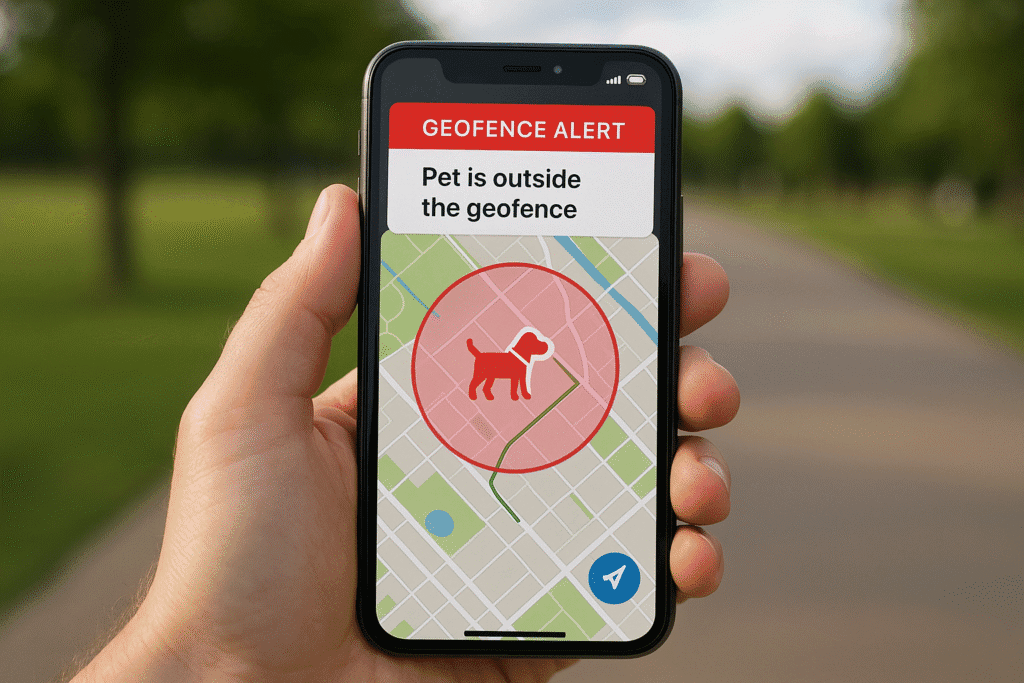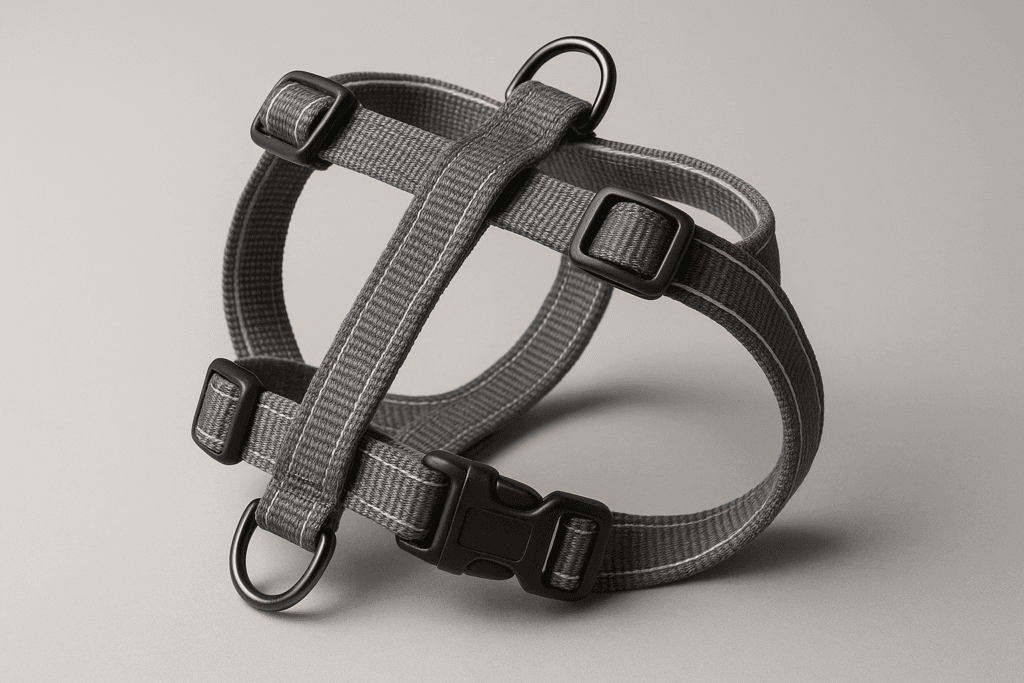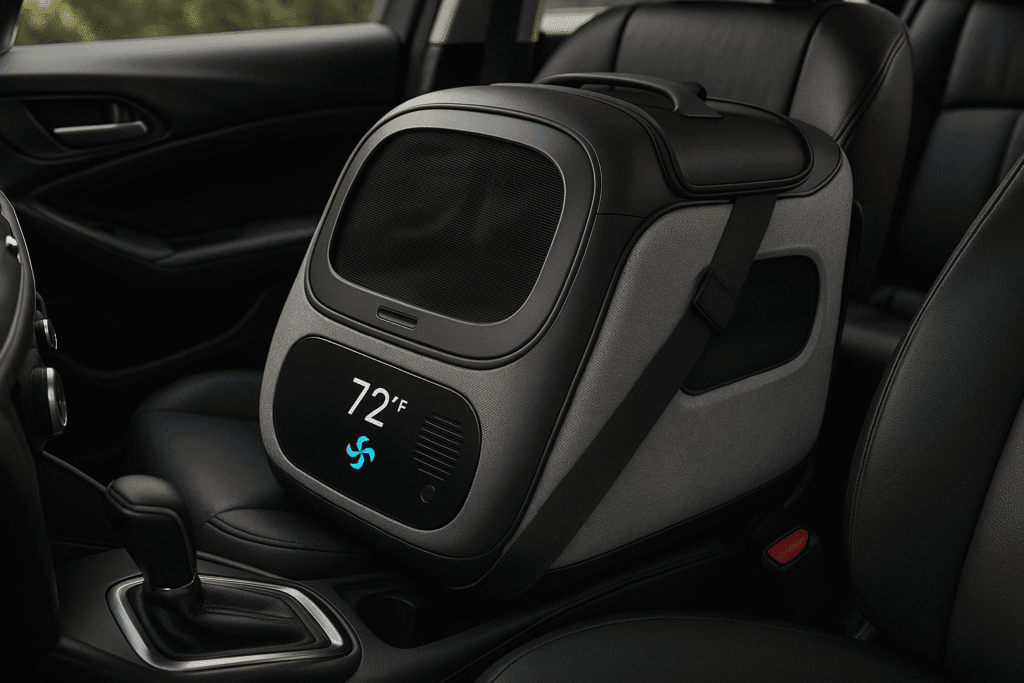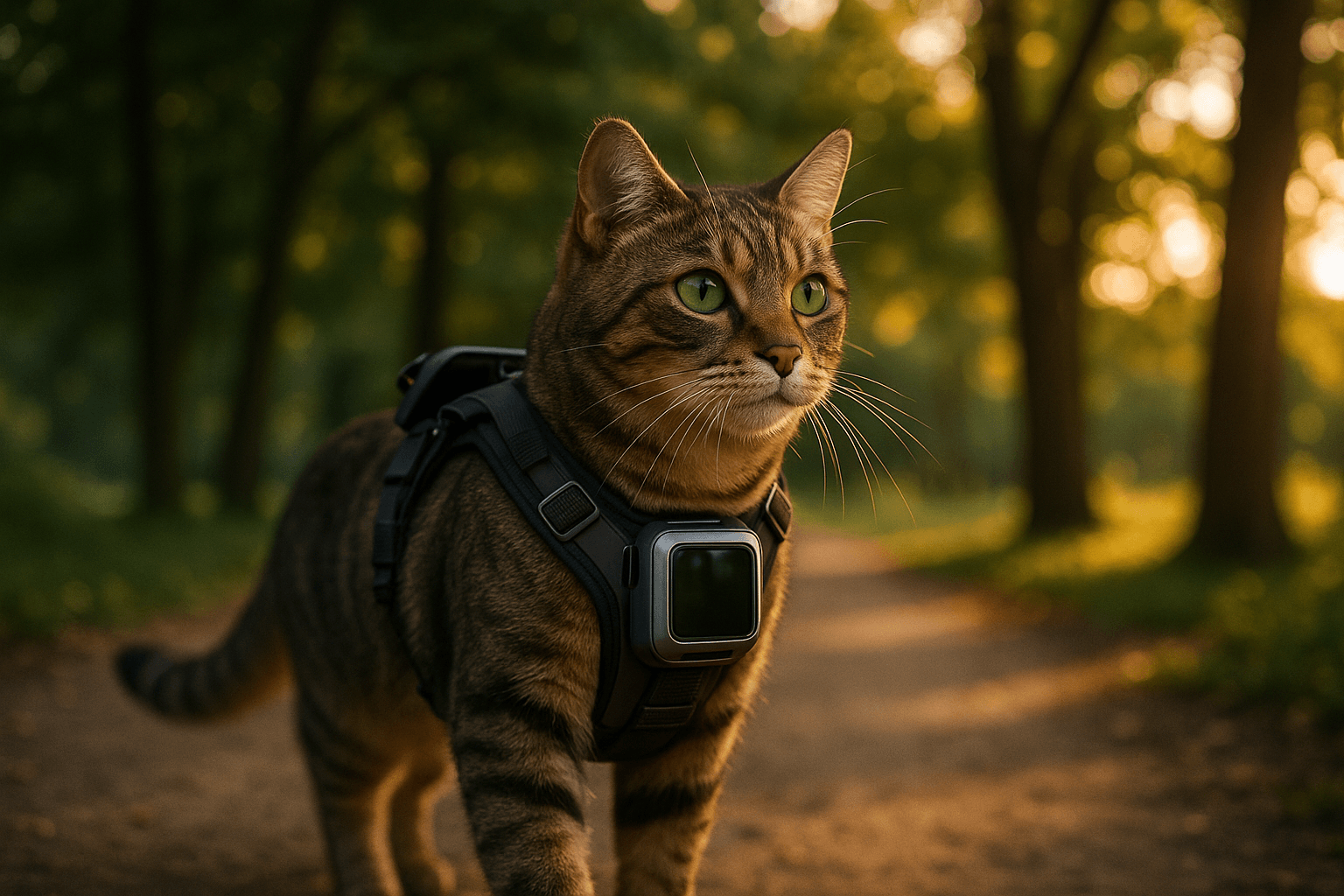Letting your cat explore the world beyond your front door is exciting, but it also introduces unfamiliar variables: cars, predators, toxic plants, heat, and noise. The good news is that modern pet technology turns uncertainty into control. With GPS trackers, AI-enhanced harnesses, smart carriers, and real-time monitoring, you can design outdoor time that is genuinely safe, enriching, and predictable for your cat. In this guide, we lay out a complete blueprint — smart outdoor cat safety.
Why a Tech-First Approach Works
Outdoor enrichment supports mental health and reduces boredom, but unmanaged risk can erase those benefits. A tech-first approach gives you objective signals: location, temperature, hydration, and activity trends. With that information, you can intervene before a problem escalates—cutting short a walk if the heat index spikes, finding a cat that slipped a fence, or recognizing early fatigue after a long hike. Authoritative resources like the AVMA and the Cornell Feline Health Center emphasize supervised exploration, identification, and preparation. Outdoor enrichment, done thoughtfully, can be part of a healthy routine when paired with the right tools and training. Outdoor enrichment supports mental health — smart outdoor cat safety.
GPS Trackers: Non-Negotiable for Outdoor Time

A lightweight GPS tracker is the foundation of any safe outing. The best devices deliver minute-by-minute location updates, escape-zone alerts, and route history. Crucially, they also reveal context—how fast your cat is moving, where they tend to stop, and whether their activity aligns with their baseline. Look for:
- Real-time precision with reliable cellular coverage and fallback locating.
- Virtual fences that ping you the second a boundary is crossed.
- Activity & wellness data (rest, calories, steps) to spot overexertion.
- Battery life measured in days, not hours, and water resistance for rain or dew.
If you already own a tracker for indoor monitoring, verify outdoor accuracy in your neighborhood before heading to trails. Test recall: place your cat with a safe handler, step out of sight, and confirm the app’s live location and alert timings. A lightweight GPS tracker is the foundation — smart outdoor cat safety.
Smart Harnesses: Fit, Feedback, and Visibility

A good harness prevents escapes; a smart harness adds information. Newer models distribute pressure across the chest to avoid choking, integrate reflective materials for dusk walks, and pair with apps to flag stress-related movement (rapid head turns, crouching, tail tucking). What to prioritize:
- Escape-resistant design (Y-shaped front, secure belly strap, double buckles).
- Adjustability at neck and girth to accommodate seasonal weight changes.
- High-visibility elements or clip-on beacons for night routes.
- Sensor integration, from inertial units to BLE modules, when available.
Practice indoors first: three 5-minute sessions a day for a week. Reward calm standing, then short steps, then longer corridors. Do not attach a leash until your cat reliably accepts the harness without bunny-kicking or freezing. A good harness prevents escapes — smart outdoor cat safety.
Smart Carriers and Travel Systems

For car or public transport, a well-ventilated, crash-tested carrier is essential. Smart carriers go further with temperature, humidity, and air-quality sensors you can check from your phone. Many include adjustable fans, UV-blocking panels, and interior lights for low-stress checks in dim parking garages.
Checklist:
- Rigid frame or verified crash protection.
- Sensor readouts for internal climate.
- Secure seat-belt anchors and zipper locks.
- USB pass-through to power trackers or fans on long trips.
Pair the carrier with a non-spill water bowl and a cooling mat in warm months. In winter, use an insulating pad and pre-warm the car to avoid cold shock. For car or public transport — smart outdoor cat safety.
Portable Cameras and Live Monitoring
Pocket-sized action cams can clip to a harness or mount on a chest plate, while compact Wi-Fi cameras can ride inside the carrier. They are not about “surveillance” so much as behavior translation: reviewing footage reveals what startled your cat, where they felt most comfortable, and how they signaled fatigue. Over time, you’ll build a route library—quiet streets at noon, shaded paths at 5 p.m.—that minimizes triggers. Pocket-sized action cams — smart outdoor cat safety.
Heat, Hydration, and Environmental Sensors
Heatstroke and dehydration are the most common preventable outdoor emergencies. Wearables that flag elevated body temperature or sudden lethargy give you minutes of head start. Combine that with a collapsible bottle-and-bowl system and scheduled water breaks every 15–20 minutes in warm weather. If your route lacks shade, plan micro-stops under trees and avoid dark pavement that radiates stored heat. Heatstroke and dehydration — smart outdoor cat safety.
Add an air-quality and pollen check to your pre-walk routine. High particulate loads or grass surges can irritate airways, especially in brachycephalic cats. Consider paw balm for hot sidewalks and rinse paws after winter salt exposure.
Training for Calm, Confident Exploration
Technology is a support, not a substitute, for training. Use a shaping plan:
- Harness neutrality indoors (no treats needed to tolerate it).
- Leash introduction with gentle, slack handling—never drag.
- Door thresholds: pause, look, treat; teach patience at exits.
- Short yard sessions (<5 minutes), building to sidewalk loops.
- Recovery rituals: water, grooming, and a calm hideaway on return.
Mark progress in your tracking app. If a session yields more startle events than the previous week, shorten the next outing and add decompression play at home. Technology is a support — smart outdoor cat safety.
Route and Risk Planning
Before each session, do a 60-second check:
- Forecast and UV index; skip mid-day heat.
- Traffic and construction noise on your intended route.
- Dog walking hours in your park (ask regulars or rangers).
- Wildlife reports (raccoons, coyotes) and local leash rules.
Create two route templates: “confidence walks” (predictable, quiet) and “novelty walks” (new sights with low risk). Before each session — smart outdoor cat safety.
Turn Device Data into Safer Habits
Your apps are collecting gold: peaks in activity, typical rest points, the minute of the day your cat tends to spook. Translate those patterns into decisions.
- If heat alerts cluster after 20 minutes, cap sessions at 15 and add shade breaks.
- If escapes happen at gates, build a “sit and watch” routine at every threshold.
- If night walks produce fewer startles, shift your schedule and add reflective gear.
Periodic reviews also surface gear tweaks: a different harness cut, a lighter camera, or a battery pack for trips that run long. Your apps are collecting gold — smart outdoor cat safety.
Recommended Gear Framework (Build Your Kit)
- GPS tracker with live tracking and safe zones.
- Smart harness with reflective elements and secure buckles.
- Leash (4–6 ft) with a bit of shock absorption.
- Smart carrier with climate sensors for car rides.
- Hydration kit (collapsible bottle + bowl).
- Clip-on light for twilight visibility.
Buy once, cry never: prioritize reliability, service support, and replaceable parts over cosmetic features. Buy once, cry never — smart outdoor cat safety.
Affiliate Picks
- PETKIT Breezy Dome 2 Smart Carrier — climate monitoring and ventilation suitable for car travel (affiliate).
- Tractive Cat Mini GPS — real-time tracking with geofences and activity trends (affiliate).
- Whisker Feeder-Robot — schedule meals that align with your travel routines and hydration plan, managed from the Whisker app. Get the Feeder-Robot — $50 Off with Code REALSIMPLE50
Choose vendors you trust and keep firmware updated; new releases routinely improve accuracy and battery life. Choose vendors you trust — smart outdoor cat safety.
Pre-Adventure Checklist (Save This)
- Battery levels: tracker, phone, beacons, fans.
- Fit check: two-finger rule at neck and girth, buckles locked.
- Weather logic: shade plan, water schedule, paw-pad safety.
- ID and microchip registered with current contact info.
- Route options A/B if noise or dogs appear.
- Post-walk recovery: cool water, wipe paws, quiet space.
Battery levels — smart outdoor cat safety.
FAQ
Is outdoor time safe for every cat?
Not always. Very anxious cats, those with cardiac or respiratory disease, or cats in extreme climates may be better served by enclosed patios (catios) and stroller exploration. Speak with your veterinarian before starting. Not always. Very anxious cats — smart outdoor cat safety.
Do I still need ID if I have a tracker?
Yes. Collars with tags and a registered microchip backstop technology failures and help neighbors return your cat quickly if they find them.
Conclusion: Freedom, But Make It Planned
You do not need to choose between enrichment and safety. With deliberate training, thoughtful routes, and trustworthy devices, outdoor exploration becomes a predictable, restorative routine. Start small, log your data, and keep iterating—your cat will tell you, in posture and pace, when the plan is working. You do not need to choose — smart outdoor cat safety.
As you iterate, keep a simple note in your app: smart outdoor cat safety is a habit, not a one-time setup.
Authoritative Resources (Outbound)
- Cornell Feline Health Center — enrichment, stress reduction, environmental risks.
- AVMA — travel checklists, restraint advice, heat safety for pets.
- ASPCA — toxic plants database for yards and walking routes.
Use these alongside your veterinarian’s advice, especially for medical conditions or extreme climates.
Internal Links to Explore Next (Build Topic Authority)
- Best GPS Trackers for Cats 2025 — fit and battery comparisons. (Travel & Outdoor Safety)
- Best Smart Cat Harnesses 2025 — comfort and escape-proofing. (Travel & Outdoor Safety)
- Smart Cat Doors 2025: Safety Meets Freedom — controlled access. (Hygiene & Home Safety)
- Smart Cat Cameras 2025 — indoor monitoring that complements outdoor routines. (Hygiene & Home Safety)
- Hydration & Nutrition on the Go — portable fountains and treats. (Feeding & Nutrition)
Ready to Gear Up?
Start with one reliable tracker and a harness your cat actually enjoys wearing. Add a climate-aware carrier if you travel by car or transit. When you’re ready, review our curated picks and compare prices across Amazon, PETKIT, and Whisker to support your preferred vendor.
Affiliate Disclaimer
This article contains affiliate links. PetTech AI may earn a commission from Amazon, Whisker, and PETKIT at no extra cost to you. We only recommend products we would use with our own cats. Our selections support smart outdoor cat safety across devices and scenarios.


Leave a Reply